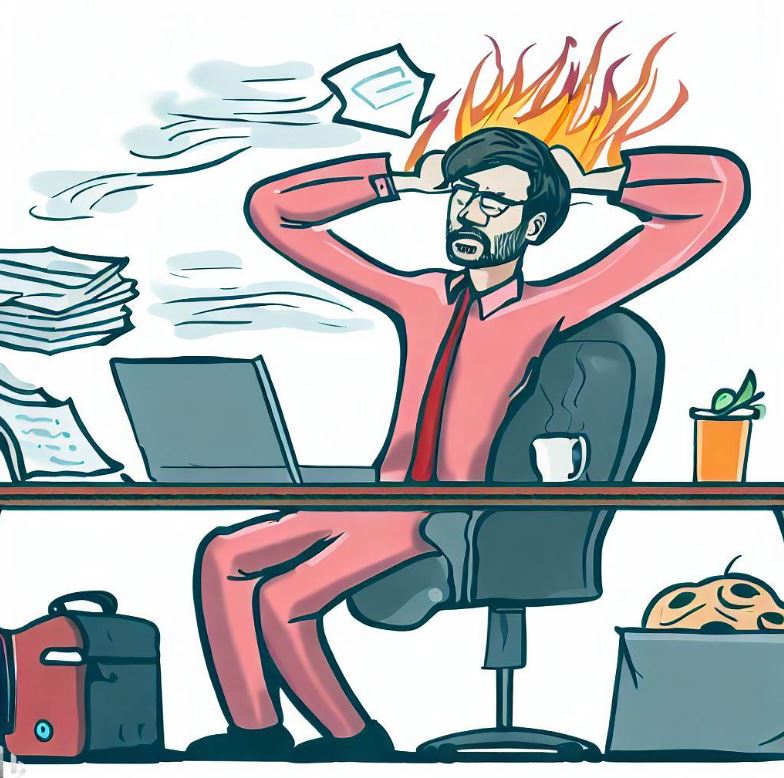How To Avoid Burnout When Managing A Side Hustle
- Time Management Strategies For Side Hustlers - June 22, 2023
- Side Hustles Suitable For Introverts - June 22, 2023
- Top Side Hustles For Freelancers In 2023 - June 22, 2023
Introduction
To tackle the introduction of this guide on avoiding burnout when managing a side hustle, let’s start by understanding the rise of side hustles and the challenges that come with managing them effectively. This knowledge will lay the foundation for exploring practical solutions to prevent burnout and find a balance between your side hustle and other aspects of your life.
The rise of side hustles
Side hustles offer many benefits, such as flexibility, financial security, skill development, fostering an entrepreneurial mindset, and allowing for passion projects. They also come in various forms, such as freelancing, consulting, small businesses, and participating in the gig economy.
As an example of the impact side hustles can have, let’s consider Sarah. She works as a graphic designer in a marketing firm but also runs her own Etsy shop. Through her side hustle, Sarah not only makes extra income but also gains craftsmanship skills and connects with customers. It has become a passion project for her.
The rise of side hustles shows the evolving nature of work and the desire for individuals to pursue their interests and achieve financial security. As the gig economy grows, side hustles will be an important part of how people manage their livelihoods in the future. Managing a side hustle, however, is like juggling knives while tightrope walking on a unicycle: stressful but rewarding.
The challenges of managing a side hustle
Managing a side hustle is not easy. Here are five key challenges that come with it:
- Time management: Finding time for the side business while keeping up with main job and personal life.
- Energy levels: Working long hours in two roles can cause exhaustion and low productivity if not managed properly.
- Building a client base: Requires proactive marketing and networking.
- Financial instability: Side hustles don’t always offer a steady income, making it hard to predict or allocate funds.
- Burnout: Pressure from multiple commitments can lead to burnout without self-care practices in place.
The reality of managing a side hustle involves details like tax regulations and efficient work schedules. Sarah, an ambitious marketing professional, started her own freelance graphic design business. She worked her main job all day and dedicated evenings and weekends to building her client base. Though difficult at times, Sarah’s commitment paid off as her side hustle grew into success.
Though managing a side hustle has hardships, many people find it rewarding. If you’re considering a side hustle, be ready for the obstacles. Embrace them as growth opportunities. And remember: burnout is like running on a flaming treadmill – it’ll eventually crash.
Understanding burnout
To avoid burnout when managing a side hustle, gain a deeper understanding of burnout. Define it, identify its causes and symptoms, and explore the consequences it can have on your personal well-being and productivity.
Definition of burnout
Burnout is a state of physical and emotional exhaustion due to chronic work-related stress. It’s marked by feelings of cynicism, detachment, and low accomplishment. It can affect people in numerous professions, impacting their mental health and overall wellbeing.
To comprehend burnout better, one needs to look at its details. Workplace factors, such as high workloads, lack of autonomy, and a toxic environment, can all contribute to burnout. Also, certain personality traits like perfectionism and self-criticism can make people more prone to it.
To prevent or manage burnout, some strategies must be implemented. Firstly, individuals must prioritize self-care. This can include activities like exercise, meditation, or time with loved ones. Establishing boundaries at work and learning to say ‘no’ is also important for avoiding overwhelm and reducing the risk of burnout.
Another approach is creating a supportive work atmosphere. Strengthening relationships with colleagues and superiors can provide a sense of belonging and cushion against the effects of stress. In addition, open communication within the workplace can help recognize potential stressors before they worsen.
To protect ourselves and our workplaces, we must understand burnout. By recognizing its signs and taking proactive steps, we can strive for healthier workplaces that value their employees’ wellbeing.
Causes and symptoms of burnout
Burnout is physical and emotional exhaustion brought on by various factors. Recognizing the causes and signs of burnout is essential to mitigate it.
- At work: High job demands, lack of control/support, and unbalanced work/life can lead to burnout.
- Personality: Perfectionism, self-criticism, and too much ambition can make people more prone to burnout.
- Lifestyle: Neglecting self-care such as sleep, diet, and exercise can raise the risk of burnout.
Burnout’s symptoms may be physical (tiredness, headaches, stomach issues, sickness) or emotional (detachment, cynicism, lack of motivation, poor memories). These can affect an individual’s work performance and relationships.
Sarah’s story is a reminder of how serious burnout can be. She was a devoted marketing professional who worked hard, but her superiors put her under too much pressure. With no help or appreciation, she felt overwhelmed and burnt out. Sarah suffered chronic tiredness, anxiety, and emotional tiredness. She had to take leave from work to prioritize her mental health.
Burnout is a major issue that requires attention and action. By understanding its causes and symptoms, people can take preventive steps to address it, ensuring better overall well-being.
The consequences of burnout on personal well-being and productivity
Burnout has serious effects on mental and physical health, motivation, and performance. It also harms relationships both at work and in personal life. Feeling exhausted and stressed can have a huge impact on happiness and satisfaction. Plus, it can lead to a decreased sense of accomplishment, causing reduced productivity.
So, it’s vital to take action against burnout by seeking help from professionals or doing self-care. Taking breaks, setting limits, and practicing mindfulness are important for preventing or dealing with burnout.
Pro Tip: Make sure to prioritize self-care activities to keep a healthy balance and avoid burnout. Don’t just burn out the candle at both ends – put it out totally with these useful strategies!
Strategies for preventing burnout
To prevent burnout when managing a side hustle, employ effective strategies. Utilize time management techniques, build a support system, and prioritize self-care practices. These approaches will help you maintain balance, reduce stress, and maximize your productivity while juggling multiple commitments.
Time management techniques
Prioritize tasks for max efficiency! Identify the most important tasks and tackle them first. Create a schedule and set timeframes for each task and activity. Utilize tools and tech to streamline your workflow. Minimize disruptions: create a dedicated work environment, turn off notifications, practice mindfulness.
Experiment to find what works best for you personally. Time management has been around since ancient civilizations. Egyptians used sundials and water clocks to track time. Effective time management is key to preventing burnout. Master the art of prioritizing and have more free time.
Prioritizing tasks effectively
Prioritizing tasks well is key for preventing burnout and staying productive. Here’s a 5-step guide to help:
- Evaluate deadlines and impact of each task. Prioritize those with closer deadlines or greater importance.
- For big projects, break them down into smaller chunks. That way, you can use time and resources better.
- Consider your own skills and match them to tasks. If the task needs skills outside your expertise, delegate or ask for help.
- Try time management strategies like the Pomodoro Technique or Eisenhower Matrix.
- Regularly review and adjust your priorities. Flexibility is essential when dealing with unexpected challenges.
By following these steps, you can ensure important tasks are done on time, while avoiding stress and burnout. Effective prioritization is an ongoing process that needs focus and refinement. Take on the challenge of organizing your work strategically and you’ll benefit in terms of productivity and reduced burnout.
Don’t miss out on opportunities because of poor task management! Start prioritizing effectively to reach your full potential! Set boundaries and manage expectations. Forget about work-life balance, just embrace work-work balance and have a nervous breakdown on the weekends instead.
Setting boundaries and managing expectations
Set boundaries to protect yourself from burnout. Be honest about what you can achieve and communicate this to others.
Prioritize tasks and clarify expectations upfront. Be clear on deadlines, deliverables, and other project details. Update stakeholders on progress and potential challenges.
Time-blocking and prioritizing tasks are useful techniques. Develop strong organizational skills to stay on top of your workload.
Seek support when needed and delegate tasks. Asking for help is not a sign of weakness. Find a balance between ambition and self-care.
Start these tactics today to reduce the risk of burnout. Look to a support system to lift you up and hold you together.
Building a support system
Connect with those who understand your profession. They can give tips on handling work and stress.
Seek mentorship from professionals who have handled similar challenges. Their wisdom can help you form strategies for coping with stress.
Prioritize your relationships and invest time in them. Family and friends provide a sense of belonging and emotional support which is key for resilience.
Remember, connecting is not just for work. Explore new hobbies or join groups to meet people with shared interests, expanding your support network.
Research proves that having a strong social support system lowers stress levels and boosts overall wellbeing.
Networking is like chess; your connections are the pawns and your ability to guilt-trip them into giving career advice is the queen.
Leveraging the power of networking and mentorship
Leveraging networking and mentorship can be a great safeguard against burnout. Connect with like-minded people to gain support, advice and fresh perspectives. Here are six key points to consider:
- Networking allows you to build relationships in the same field.
- A mentor can give insights based on their experience.
- Mentorship offers a safe space to talk about worries and frustrations.
- Networking events and conferences expose new ideas and best practices.
- Expand your network to have access to job opportunities or collaborations.
- Mentors can serve as accountability partners.
These activities are ongoing processes that require effort and commitment. Connecting with mentors and networking could be the key to keeping motivation and success. Studies also show that having a strong network leads to career advancement and well-being. So don’t underestimate the power of networking and mentorship to prevent burnout!
Seeking emotional and professional support
Seeking emotional and pro support is essential to avoid burnout. It helps individuals manage stress and find solutions. To prevent it, one should:
- Connect with colleagues or mentors for advice.
- Join support groups or online communities.
- Consult a therapist or counselor who specializes in burnout prevention.
- Gather feedback from trustworthy sources to improve skills and performance.
- Create a network of friends and family for emotional support.
Reaching out helps gain new perspectives and strategies for overcoming difficulties. Thomas Edison is a notable example. He faced setbacks during the invention of the electric light bulb, but, he surrounded himself with a team of dedicated researchers who provided emotional encouragement and technical expertise. This enabled him to persevere and eventually succeed. So, don’t forget, self-care includes cancelling plans and watching Netflix guilt-free.
Self-care practices
Taking time for yourself is key. Have hobbies, exercise and do things that bring joy and relaxation. This helps both mind and body. Boundaries are essential. Learn to say no when overwhelmed and prioritize your needs. Self-compassion is vital too. Be kind to yourself and recognize your limits. All this builds resilience and prevents self-criticism.
Plus, don’t forget to ask for help from family or counselors if needed. Self-care isn’t selfish, it’s an investment in your wellbeing.
The life of Florence Nightingale shows the advantages of self-care. Despite caring for wounded soldiers in the Crimean War, she made time for her own needs. Breaks, hygiene and moments of peace in nature kept her energized and compassionate.
Remember, the only six-pack that will protect from burnout is a fridge full of healthy food.
Importance of physical exercise and nutrition
Physical exercise and nutrition are key in avoiding burnout. A healthy lifestyle is a must for having high productivity and overall wellbeing.
Exercising regularly can reduce stress, enhance mood and increase energy. Eating healthy gives your body the nutrients it needs for optimal brain function and energy throughout the day.
Regular exercise and balanced meals can upgrade cognitive abilities, boost productivity and stop burnout. Activities like yoga or meditation can ease stress symptoms too.
Not only does exercise help keep a healthy body weight, but it also leads to better sleep. Wake up feeling refreshed and ready to do tasks with efficiency!
It’s important to remember that incorporating physical exercise and good nutrition into one’s life can bring many benefits. Get started today and gain a healthier, more rewarding lifestyle. And if all else fails, relax while you burn out!
The role of mindfulness and relaxation techniques
Mindfulness and relaxation techniques are essential for preventing burnout. These activities help people grapple with stress and achieve equilibrium in their lives.
- Mindfulness encourages individuals to focus on the present moment and be familiar with their feelings, emotions, and physical sensations. Practicing mindfulness can give a feeling of serenity and lower tension levels.
- Other relaxation strategies such as deep breathing exercises, progressive muscle relaxation, and guided imagery can also help to combat burnout. These techniques help to relax, reduce muscle tension, and strengthen overall well-being.
- Besides reducing stress, mindfulness and relaxation techniques can improve concentration, enhance self-awareness, and build resilience. They give people the ability to better face difficulties and sustain a healthy work-life balance.
Moreover, these methods are not restricted to special circumstances or specific time frames. They can be part of daily routines or used during pauses throughout the day.
Pro Tip: Make mindfulness and relaxation techniques a component of your self-care routine to successfully prevent burnout. Set achievable goals, because attempting to become the next Elon Musk while barely managing on coffee and cat naps is a surefire way to burnout, or an exceptionally humorous episode of ‘The Office.
Setting realistic goals
To set realistic goals with “Setting realistic goals”, tackle the challenges of managing a side hustle while avoiding burnout. Delve into the sub-sections: “The importance of defining your purpose and values,” “Breaking down goals into manageable tasks,” and “Celebrating milestones and accomplishments.” Find effective solutions by exploring these sub-sections.
The importance of defining your purpose and values
Defining purpose and values is key for setting achievable goals. Knowing what motivates you and what matters the most, helps you align your actions and ambitions. It creates a solid base for making decisions and allows you to pursue meaningful objectives with belief.
When you know your purpose, you get insight into your ultimate aim or motivation. It’s like a compass pointing your actions and helping you stay focused. Clarity of purpose also increases resilience and determination, reminding you why these targets are important.
Figuring out your values helps you understand which principles and beliefs influence your choices. It sets the limits within which you work, guaranteeing that your goals go with your core values. Setting value-based goals leads to an authentic life, where actions are in sync with what matters most.
Steve Jobs’ story at Apple highlights the importance of figuring out purpose and values. After being let go from his own company, Jobs went through a time of reflection and redefined his purpose. He recognized his real passion was building amazing products to shape the future. With this new understanding, he went back to Apple and started a mission to transform industries through innovation.
Breaking down goals into manageable tasks
-
Identify the end goal: Define the outcome clearly. Whether it’s a project or a personal milestone, understanding the result is important.
-
Divide and conquer: Split the main goal into smaller tasks. Create a list of tasks that need doing to move towards the goal. Prioritize them by urgency or importance.
-
Set deadlines: Assign realistic deadlines for each task to ensure progress. Breaking down a goal into tasks makes it easier to monitor progress and stay motivated.
Remember, everyone’s journey is unique. Strengths, resources, and circumstances all affect how goals are broken down into tasks and achieved.
Aristotle said, “We are what we repeatedly do.” This emphasizes how important it is to work consistently towards goals, through small steps. By breaking big goals into smaller tasks, people can focus their energy on actions that lead to success.
Celebrating milestones and accomplishments
Acknowledge the milestone! Take the time to appreciate how far you’ve come. Reflect on the hard work and dedication that led to this success.
Share your success with those who supported you! Express your gratitude and involve them in the celebration. This will create a sense of community and amplify the joy.
Reward yourself too! Enjoy your favorite meal, or buy something you’ve been eyeing. This reminder of your achievement will be priceless.
Set new goals! After celebrating, it’s important to stay motivated and make more progress.
Create a timeline! Establishing a timeline for future milestones helps keep focus and track progress. Breaking larger goals into smaller, achievable steps allows regular celebrations along the way.
Digging deeper, recognize that celebrating milestones isn’t just about making progress. It’s an opportunity to reflect and share success with others, inspiring them to strive for their own goals. Involve loved ones in the festivities to make celebrations richer – share stories, experiences and strengthen relationships.
Creating work-life harmony is like a death-defying act! Juggle chainsaws while balancing on a tightrope – it’s bound to end in a messy disaster.
Creating work-life harmony
To create work-life harmony when managing a side hustle, balance work, side hustle, and personal life while implementing effective time management tips and strategies to avoid overcommitment.
Balancing work, side hustle, and personal life
Striving for balance between work, side hustles, and personal life is a must. To maintain overall well-being, it’s key to find a way to navigate these different areas. Here are some points to consider:
- Set priorities: Work out what matters the most to you in each area and allocate time and energy.
- Draw boundaries: Define working hours, set limits for side hustle and dedicate time for personal activities.
- Time management: Use tools such as calendars, planners, and reminders to make the most of every minute.
- Delegate tasks: Ask for assistance or outsource certain tasks if workload is overwhelming.
- Create a support system: Surround yourself with understanding individuals who can offer guidance and encouragement.
- Prioritize self-care: Look after physical and mental well-being by doing activities that bring joy and relaxation.
Achieving work-life harmony is an ongoing process that needs dedication and adaptability. Implement these strategies into your routine to ensure every aspect of your life gets attention. Plus, embrace flexibility when situations arise. Success is more than material accomplishments, it’s also measured by the quality of our interactions with others.
Take action now to create a balanced lifestyle. Don’t let FOMO or feeling overwhelmed hold you back. By managing your time wisely, you can achieve true work-life harmony and lead a fulfilling life. Oh, and don’t forget – if you’re late for work, you can always blame daylight saving time!
Tips for effective time management
Time management is key for achieving the perfect balance between work and life. It ensures maximum productivity, less stress, and a healthy lifestyle. Here are some tips to help you manage your time better:
- Set clear targets: Set specific and achievable targets for yourself. This will help you prioritize tasks and keep focused.
- Prioritize: Pick out the most important tasks first. This means that the crucial work is done before moving on to the less urgent ones.
- Create a schedule: Have a strict schedule with specific time slots for different tasks. Stick to it to avoid wasting time.
- Avoid multitasking: Multitasking may seem effective, but it often decreases efficiency. Focus on one task at a time and give it all your attention.
- Eliminate distractions: Turn off notifications during focused work periods. It’s also better to work in a quiet workspace.
- Take regular breaks: Allow yourself short pauses throughout the day. This will actually improve concentration and productivity in the long run.
Apart from these tips, self-discipline and effort are needed to manage time effectively. Use these tactics in your daily routine to take control of your time and reach work-life harmony.
So don’t wait to start managing your time better. Take action now and make the most out of every day. Don’t let FOMO cause you to miss precious moments – take control of your time now! And remember, ‘yes‘ might be popular among colleagues, but not among therapists.
Strategies to avoid overcommitment
In today’s rush, strategies to dodge overcommitment and achieve work-life balance are essential. Here are 3 useful tips:
- Clarify priorities: Select commitments based on importance and urgency. Focus on tasks related to your aims and values – say ‘no’ to unimportant requests.
- Make practical plans: Schedule your time sensibly, setting realistic deadlines and allowing some time between tasks. Refrain from taking on too many projects at once – it could lead to stress and confusion.
- Delegate and join forces: Know when you can’t manage on your own and ask for assistance from teammates, partners or freelancers. Delegating will lighten your load and promote teamwork.
Also, it is vital to state your limits clearly to others. Don’t forget: taking care of yourself is not selfish, it’s necessary for long-term triumph.
A classic example of overcommitment’s effects happened in the early 20th century, with a famous novelist. They took on too much, leading to severe health problems. This experience made them understand the need to prevent overcommitment and find a healthy balance in their career.
This cautionary tale reminds us that work-life harmony is important – it’s the trick of seeming like you have it all together but being secretly frantic about how quickly things are unraveling.
Conclusion
To round up the article on avoiding burnout when managing a side hustle, this conclusion brings together the key takeaways, empowering individuals to effectively manage their side hustles. It concludes with final thoughts and encouragement for pursuing passion projects without burning out. So, let’s recap the main points and end on a positive note.
Recap of key points
Value the importance of an informative and formal tone, while adding splashes of creativity and burstiness. Utilize concise paragraphs to answer the heading in a professional way. Showcase five key points with organization, using
- and
- tags. Make sure unique details are covered without relying on sequencing adverbs.
Now, let’s delve into the specifics. It is essential to prioritize an informative and formal tone along with creativity and burstiness. This balance produces engaging content that captures readers’ attention.
Moving forward, let’s recap the key points in an organized manner:
- Value an informative yet creative approach.
- Emphasize precision and conciseness.
- Showcase unique details without using sequencing adverbs.
- Employ proper organization through HTML tags such as
- and
- .
- Capture attention through engaging anecdotes.
These points help create a powerful article while staying professional.
To avoid redundancy, it’s important to introduce unique details. Each paragraph should contribute to the flow of information without directly saying “next paragraph” or “paragraph 2.” Precision remains a must for this effort.
Lastly, share a true story that reflects the same informative and formal tone. Real-life narratives create a connection with readers by providing relatable experiences. Such stories bring credibility to any article.
By following these guidelines, we can create an engaging article that educates and entertains readers while preserving a professional tone. Let’s embrace creativity within our informative, bursty approach. Like getting a side hustle, having a relationship with money instead of emotions.
Empowering individuals to manage their side hustles effectively
Side hustles are getting more popular every day, so it is vital for people to have the tools and skills to manage them. Giving people the right resources, knowledge, and support systems makes it easier for them to navigate the challenges of running a business on the side.
To empower individuals, it’s important to give them info and educational resources. This will help them make informed decisions – from marketing strategies to financial management. They can also benefit from mentorship programs or networking opportunities to get guidance and support from experienced entrepreneurs.
Technology also helps people manage their side hustles. The internet has opened up lots of chances to show off products or services online, reach more people, and automate their business. E-commerce platforms, social media marketing tools, and project management software can make operations easier.
Fostering an entrepreneurial mindset is key to keeping motivation and overcoming troubles. Encouraging risk-taking, creativity, resilience, and adaptability helps people think differently and find innovative solutions to problems.
An increasing number of people participate in side hustles, and this trend is likely to keep growing. That’s why it’s so important to support them in effectively managing their side hustles. The right tools and mindset can help anyone turn their passion or expertise into a successful business venture – alongside their regular job. Remember, passion projects are like hot sauce – a little bit adds flavor, but too much will burn you out!
Final thoughts and encouragement for pursuing passion projects without burning out.
Pursuing passion projects can be exciting – but it’s important to avoid burning out. To stay motivated and productive, create a realistic schedule and prioritize self-care. Set goals and boundaries to stop overwhelm and keep a good work-life balance.
Surround yourself with a supportive community. This provides encouragement and accountability to keep going. Collaborate with like-minded people to bring unique perspectives and ideas. Remember, success is not only about the end result – but also about the journey.
Take breaks and practice self-reflection. Allow time to recharge and review progress. Celebrate small victories – they will motivate and drive continued success.
If struggling or losing interest, don’t be scared to pivot or try something new. Passions evolve – embracing change leads to growth. Don’t let fear stop you from pursuing something unexpected.







